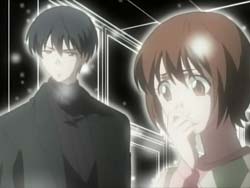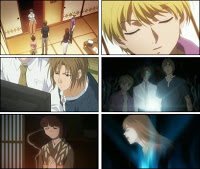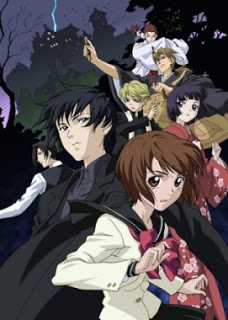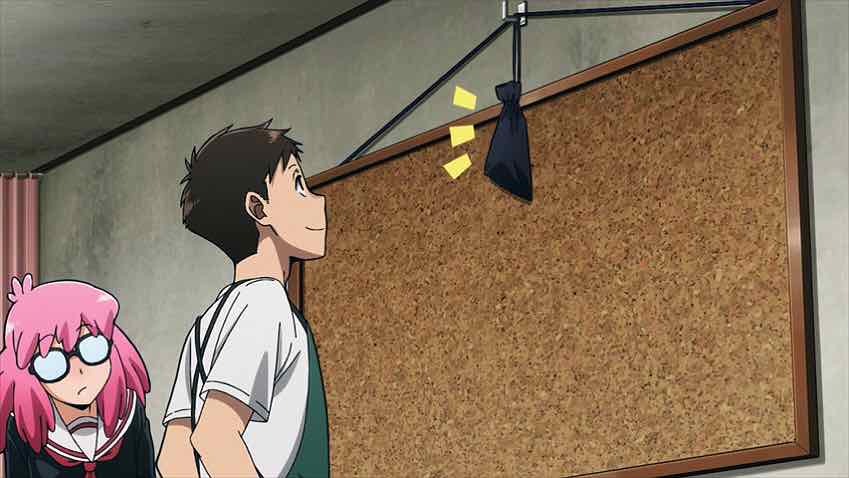A few words now about Ghost Hunt, a series I didn’t follow when it originally aired in 2006. I’ve just finished its 25-episode run. What prompted to watch it after almost five years? It was the fact that its creator, Fuyumi Ono, was also the creator of one of my favorite series of last year, Shiki. I found that to be an exceptionally well-crafted and engaging story, and it made me wonder if GH wasn’t something altogether different than the series I’d assumed it was. So was it?
Yes and no. I’d always more or less assumed GH was a kind of paranormal adventure series aimed at younger teens, based on the character designs and promo materials. While I won’t compare the show to Shiki (I couldn’t help but laugh as the term “shiki” was thrown around all over the finale), GH does have considerably more depth and real scares than the cute look would have you believe. It’s hard to know just how much of Ono’s original novel survived the transition from novel to manga and then to anime, but there’s something of the trademark wit and love of arcana that the newer series had.
 The format of the show is pretty straightforward – a series of arcs ranging from a couple of episodes to 5-6, each involving some sort of paranormal activity. Some of them were quite scary – “Doll House” and “Blood Soaked Maze” come to mind. Some were quite emotionally involving – “A Silent Christmas” was my favorite of the series. As with any such series, the quality will rise and fall dramatically with the quality of the individual story being told. The ghost stories themselves are an interesting mix of Western, Buddhist and Shinto legends.
The format of the show is pretty straightforward – a series of arcs ranging from a couple of episodes to 5-6, each involving some sort of paranormal activity. Some of them were quite scary – “Doll House” and “Blood Soaked Maze” come to mind. Some were quite emotionally involving – “A Silent Christmas” was my favorite of the series. As with any such series, the quality will rise and fall dramatically with the quality of the individual story being told. The ghost stories themselves are an interesting mix of Western, Buddhist and Shinto legends.
That’s fitting, as the cast of characters includes an Australian priest, a Buddhist monk, and a couple of Miko. The mains, though, are Naru Shibuya, the teenaged head of Shibuya Psychic Research, and Mai Taniyama, the normal-seeming 15 year-old schoolgirl who ends up working for him. In terms of darkness, this is nowhere near the level of that other Ono series – the punches are generally pulled here, although some of the scares are pretty chilling and there’s some graphic violence. There’s a lot of science and pseudo-science, a lot of mythological lecturing, but mostly a lot of verbal sparring. All of these characters love to jab at each other constantly, and Naru is the king of them all – tsundere to the max and in his flirty bishounen relationship with his assistant Lin, a fujoshi’s dream come true. While there’s certainly romantic interest in him from Mai and teen Miko Masako, there’s never much development on that front.
 Fortunately, Mai is fairly likeable as a main character. She has the function of acting as the audience proxy though many of these odd events, but she has some definite powers of her own that begin to manifest as the series progresses. There are some intriguing hints about her – she lives alone, for example – but we never touch the personal loves of any of these characters at anything more than a safe distance. That’s a major difference with Shiki, where we were constantly in the bedrooms, kitchens and offices of everyone involved. Here, the regular cast exists only in context of their work relationships and we are privileged to know the personal lives only of the clients they interact with.
Fortunately, Mai is fairly likeable as a main character. She has the function of acting as the audience proxy though many of these odd events, but she has some definite powers of her own that begin to manifest as the series progresses. There are some intriguing hints about her – she lives alone, for example – but we never touch the personal loves of any of these characters at anything more than a safe distance. That’s a major difference with Shiki, where we were constantly in the bedrooms, kitchens and offices of everyone involved. Here, the regular cast exists only in context of their work relationships and we are privileged to know the personal lives only of the clients they interact with.
In the end, this is a good series – not a great one, certainly. For a JC Staff series it looks pretty good. The music is excellent and there are certainly some nicely suspenseful and chilling moments. There are some good laughs too. It certainly lacks the emotional impact of Shiki – it’s a much safer, more sanitized experience. But to be fair, in it’s anime form at least this is a series with sharply different goals than that one had. In terms of those, I think it succeeds fairly well.




